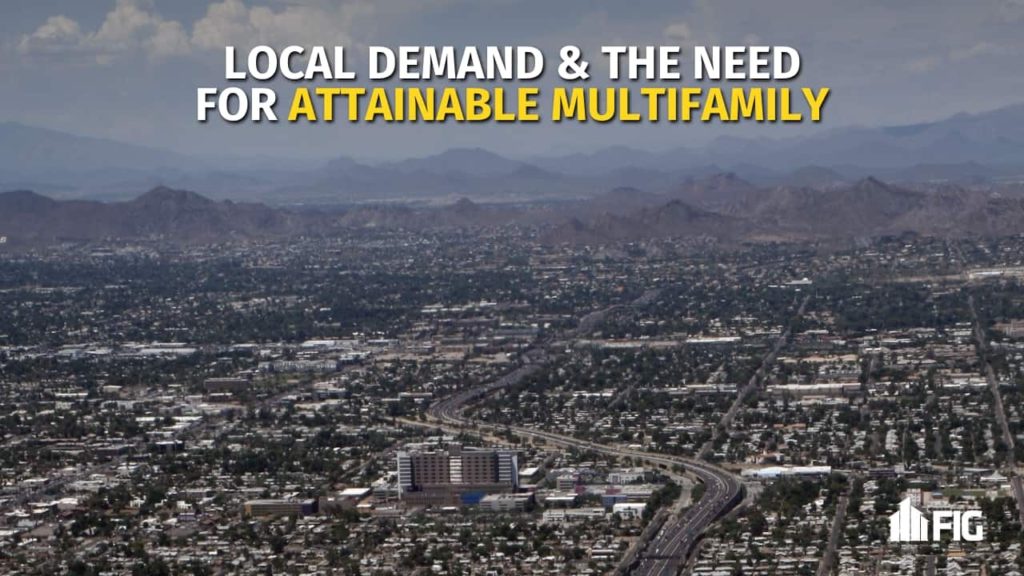
“Thank you for…the characterization of what these projects bring… When we’re talking about the types of developments that [FIG] is bringing in, the way it’s being managed for sustainability. Which means multi-generational…I think that is the proper context for communities when they’re talking about this type of investment. What it really means in the year 2021, and not the year 1980.” – Mike Hoover, Economic Development Manager (City of Surprise, AZ)
Today we’re going to discuss some of the aspects of the communities we tend to build in and what local challenges or needs the FIG fourplex model is able to help solve. Everywhere we build, attainable housing costs and prices are a problem…and it’s getting more and more difficult every single day.
We’re excited to bring a unique product type to a new real estate market this year. Our jump into Arizona has been a long time coming, specifically, Maricopa County’s West Valley. FIG’s upcoming projects should go a long way to help solve some challenges this part of the greater Phoenix metro has.
Our team’s approach to solving this problem focuses on both the resident perspective, as well as an investor perspective. You have to get the investors on board too with these developments in order to bring the necessary capital. It’s a kind of a mutual back-scratching as we like to call it.
So what is a FIG community?
For those who are less familiar with what we do, here’s a little bit of background on what our residential multifamily projects look like. It’s likely different than what you’re used to hearing from a multifamily developer standpoint.
When we say a “fourplex”, we’re talking predominantly about one tax ID number, but four units. Many of you have seen fourplexes. I think most people for their own investments intuitively understand that a fourplex is a pretty good investment.
They might say, “I think I want to do that. Maybe I could live in one of them or I could just own it and make rental income.”
That’s true. Most people understand that and get it. However, fourplexes do come with a couple of challenges that we aim to solve. This is something that is front and center as we develop new communities (primarily throughout the Intermountain West).
Local Challenges
For whatever reason, back in the 70s and 80s—builders built up a ton of fourplexes. It was all the rage.
We see this in most metropolitan areas across the country. Little hodgepodge neighborhoods of fourplexes and duplexes which eventually materialized over the years. You probably know exactly what we’re talking about here.
But if we’re really honest with ourselves, we also know that a lot of those fourplexes are in complete disrepair. They’re not in good condition. They’ve become a “bad area” of the neighborhood and are not taken care of.
Why is this?
These multifamily communities were set up with fractionalized ownership. Investor Bob owns one. Investor Susan owns another one. Ownership is all over the map. There’s no uniform maintenance or preservation standard there.
If you own a fourplex in that community, as an investor, what happens? Investor Bob across the street can let whoever he wants to move in… or let people park on the lawn… or isn’t maintaining the roof.
This is the broken window theory. The development begins to go down the drain and it becomes less desirable. We see a bunch of these neighborhoods scattered across America.
As a multifamily developer/investor, that’s not what we’re in this for.
Improving the Model
One of the reasons why we want to build a big community and not a bunch of one-off fourplexes is for specific benefits that come from scale.
FIG is known to do these large communities of quad-plexes that are owned by 20 or 30 different investors.
How do we avoid the issues we’ve seen in these older communities? Our team puts an HOA in place to manage the entire project. This HOA cleans the grounds, ensures the buildings, makes sure trash is picked up and maintains a basic level of amenity for all tenants.
Attainable Housing
Next, we’ll cover something that we’ve found to work really, really well in the Phoenix metro market. It revolves around a phrase we’ve come to love, “attainable housing”.
There’s a lot of construction happening in Arizona’s Maricopa County. A lot of multifamily construction happening. Most of the developments being built are what we would call “Class A”. These are beautiful complexes, right? They’re great! This is where you’d want to go.
However, there’s a significant portion of the population that is not in the market for that type of unit. So our goal at FIG was to deliver something that is new, that has some basic amenities like a small clubhouse, pool, a tot lot, etc.—but that is also at an attainable price for the people out there working hard.
These types of projects also help the newer and expanding local business communities in Maricopa County and the other metros that we work in.
As we put these build-to-rent projects together and attach that HOA to it, we’ll be able to bring in a lot of investors. People who want to own real estate and want to be in the multifamily space and put their capital to work.
Multi-Generational Multifamily
By the time this multifamily project is in motion, the city has a good clean community where we’ve got happy investors, happy tenants, and a happy city.
That’s the objective.
That’s what we’re known to do in the 4k+ multifamily units we’ve organized in the last decade.
Another unique position the Fourplex Investment Group offers is that each of our investors takes part in a pre-construction system with us.
We are heavily engaged with some of the local community banks, bringing a lot of construction loans to them as our investors come in. Investors take out these construction loans because when we sell a fourplex to the investor ahead of time, it takes a lot of risk off of our shoulders as a developer/builder.
This lets us sell the units at a better price to the real estate investor, letting them in on a higher return.
The entire build-to-rent process creates a sustainable way to bring new product onto the market. A product designed to age well and meet growing demand for attainable housing within the marketplace.
The “FIG” fourplex investing model has worked well so far for many investors and is something we’ve implemented throughout the Salt Lake City, Utah, Boise, Idaho, Houston, Texas, and Phoenix real estate markets.
